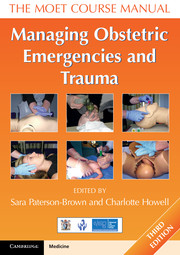Book contents
- Frontmatter
- Dedication
- Contents
- Working Group
- About the authors
- Acknowledgements
- Abbreviations
- Section 1 Introduction
- Section 2 Recognition
- 4 Recognising the seriously sick patient
- 5 Shock
- 6 Sepsis
- 7 Intravenous access and fluid replacement
- Section 3 Resuscitation
- Section 4 Trauma
- Section 5 Other medical and surgical emergencies
- Section 6 Obstetric emergencies
- Section 7 Triage and transfer
- Section 8 Human issues
- Index
4 - Recognising the seriously sick patient
- Frontmatter
- Dedication
- Contents
- Working Group
- About the authors
- Acknowledgements
- Abbreviations
- Section 1 Introduction
- Section 2 Recognition
- 4 Recognising the seriously sick patient
- 5 Shock
- 6 Sepsis
- 7 Intravenous access and fluid replacement
- Section 3 Resuscitation
- Section 4 Trauma
- Section 5 Other medical and surgical emergencies
- Section 6 Obstetric emergencies
- Section 7 Triage and transfer
- Section 8 Human issues
- Index
Summary
Objectives
On successfully completing this topic, you will be able to:
identify the current causes of maternal mortality and problems in their detection and treatment
understand a systematic approach to monitoring using early warning charts to aid recognition of women at risk
recognise ‘red flag’ symptoms and their need for urgent responses by the obstetric team and other specialties.
Introduction
In March 2011, the CMACE report for the triennium 2006–08 once again highlighted substandard care as a common contributory factor in the deaths reported. The lack of clinical knowledge across the professions at both senior and junior levels, the failure to recognise signs and symptoms of potentially life-threatening conditions and the delay in acting on findings and seeking help from appropriate specialists are all of particular concern. Attention is therefore focusing on ways to improve the recognition of, and responses to, signs of the deteriorating condition of patients.
The diagnosis of a severe life-threatening condition in a pregnant or recently pregnant woman may be difficult if the presentation is insidious or atypical. There is a potential for any woman to be at risk of physiological deterioration and this cannot always be predicted.
The early detection of severe illness in mothers remains a challenge to all professionals involved in their care. The relative rarity of such events combined with the normal changes in physiology associated with pregnancy and childbirth compounds the problem and reinforces the need for multiprofessional working.
The lessons that apply to all health professionals dealing with pregnant women can be summarised as follows:
• understand the normal changes of pregnancy in order to be able to recognise the pathological changes of serious illness – it is important to be able to distinguish between common discomforts of pregnancy and the signs of serious illness so that these signs are not ignored
• focus on getting simple things right – high-quality history taking, physical examination, meticulous recording of basic observations and findings by both doctors and midwives
• ensuring good communication and referrals between professionals.
- Type
- Chapter
- Information
- Managing Obstetric Emergencies and TraumaThe MOET Course Manual, pp. 25 - 38Publisher: Cambridge University PressPrint publication year: 2014
- 1
- Cited by

